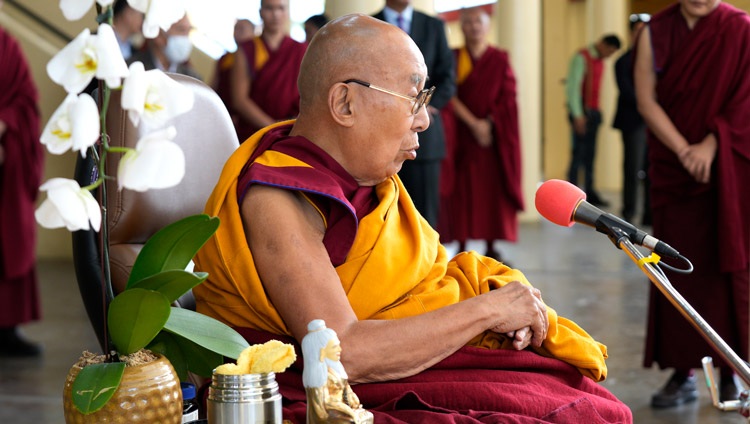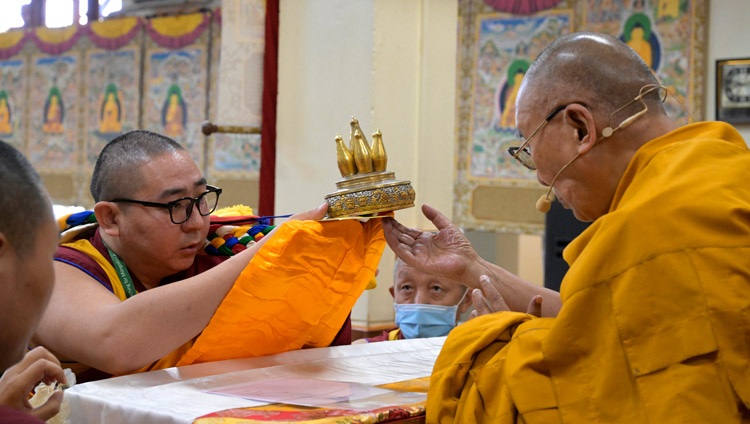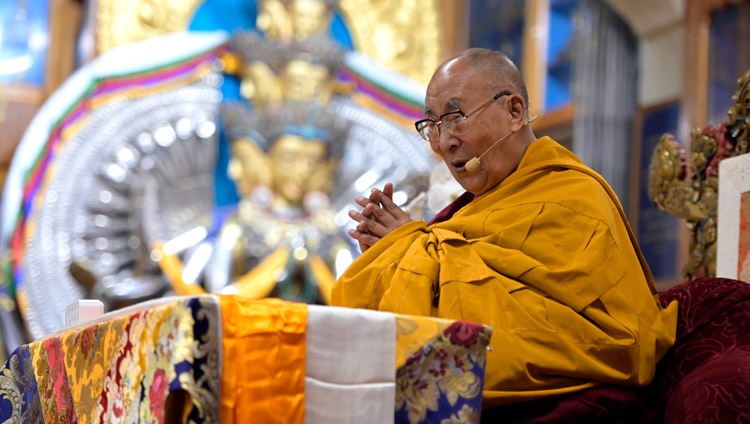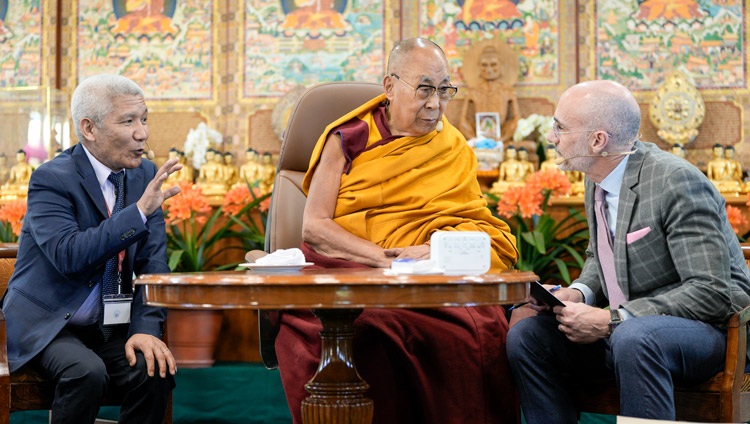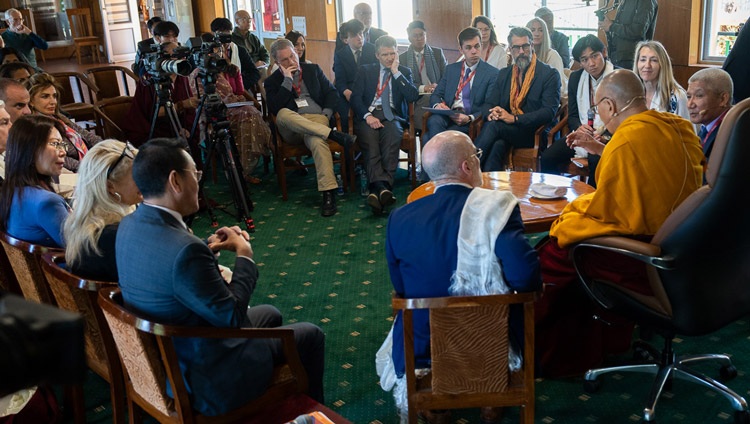Unveiling the SEE Learning Curriculum
April 5, 2019
New Delhi, India – Before joining celebrations of the launch of the SEE Learning program today, His Holiness the Dalai Lama met with a group of Indian professors who are working with Prof Samdhong Rinpoche and Prof Ngawang Samten to prepare a course of study focussing on Ancient Indian Knowledge. Prof Ngawang Samten reported that they have been designing a course based on the six orthodox schools, paying attention to their philosophy, use of logic and the way they deal with emotions.
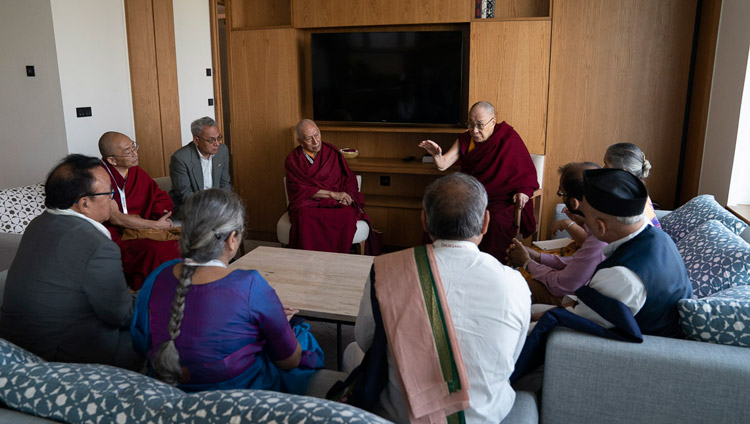
“I’m now almost 84 years old,” His Holiness told them, “and my life has been quite difficult. However, at a certain point I realized that what I had learned from the Nalanda Tradition had been of great help to me in preserving my peace of mind. It has also enabled me to sharpen my mind through analysis. Simply in day to day life, having peace of mind and being less subject to destructive emotions is very useful. I am convinced we can bring about such changes through education and that in contributing to that ancient Indian knowledge can be of benefit to the whole of humanity.
“However, the knowledge of ancient India is closely linked to religious tradition. What we need is not ritual and prayer but education in a strictly secular context.
“Mahatma Gandhi based the Indian freedom struggle on ahimsa, which some interpreted as showing weakness. I believe the practice of ahimsa—non-violence is a sign of strength. I hope you scholars and professors can tell us how we can combine it with modern education from kindergarten to university. If China, which is historically a Buddhist country, were to follow India’s example, and the more than two billion people in both countries were to cultivate inner peace, it would make a significant difference to the world.
“Yesterday, I expressed my admiration for the way all the world’s religions flourish in this country, living together side by side. For more than 20 years I’ve been encouraging the Government of India to organize an international religious conference here, much as it did to celebrate the 2500 Buddha Jayanti in 1956. Religious leaders could meet and get to know each other better. Practitioners could hold discussions and learn from one another and pilgrimages could be organized to places of worship.”
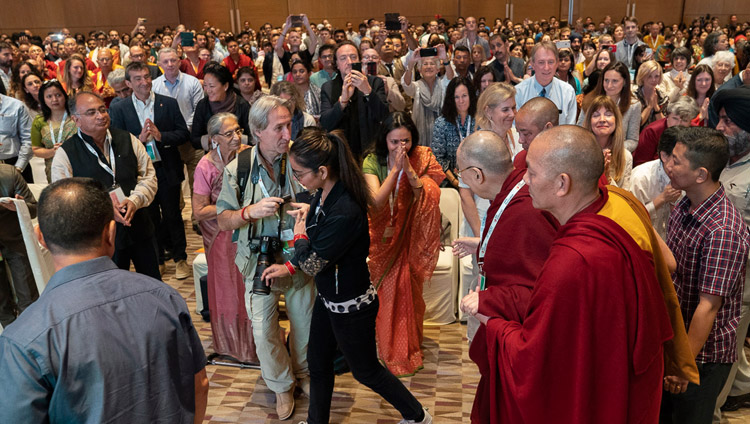
Downstairs in the meeting hall, more than 900 people awaited His Holiness’s arrival. As he walked towards the stage he greeted friends among them. He embraced Richard Moore, taking his glasses off so Moore could touch his face. Before he sat down, His Holiness insisted that the overstuffed armchair that had been provided for him be changed for the same kind of chair that everyone else was sitting on.
Master of Ceremonies Ravi Gulati stated that there is a gap in our education and the SEE Learning program seeks to fill it. He invited Tempa Tsering of the Dalai Lama Trust to introduce the occasion. He welcomed everyone to the launch of the ground-breaking SEE Learning program prepared at Emory University with His Holiness’s support.
“There has been great development in infrastructure and communications,” he observed, “but are we any happier or more contented? On the contrary there seems to be more stress, violence and greed. Improved communications facilities have made the world smaller and people are more interdependent, but are we more compassionate?
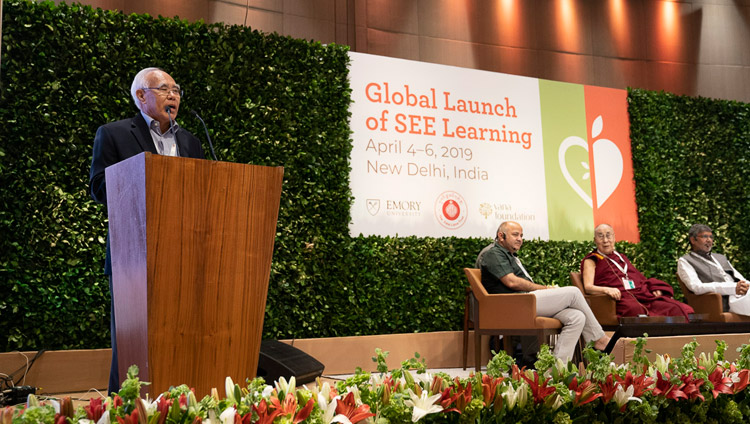
“Although His Holiness believes it is basic human nature to be kind and compassionate, modern education is not balanced and does not encourage such values. The solution is to provide a balanced education of the heart and mind.”
Veer Singh of the Vana Foundation told the gathering, “His Holiness refers to himself as a Son of India and as an Indian I’m grateful to him for reminding us of our ancient heritage—to cultivate virtue and train the mind as the Buddha did. SEE Learning is timely and appropriate.”
Dr Robert Paul, Dean Emeritus of Emory University declared that it was his great honour and pleasure to pass on greetings from Emory’s President Claire Sterk. He described the SEEL program as an inspiration at a time when the world is entering a tumultuous era. It will be, he said, a resource for the survival of our children and their children. He commended Geshé Lobsang Tenzin Negi, his former student and now colleague, for his effective leadership of the project.
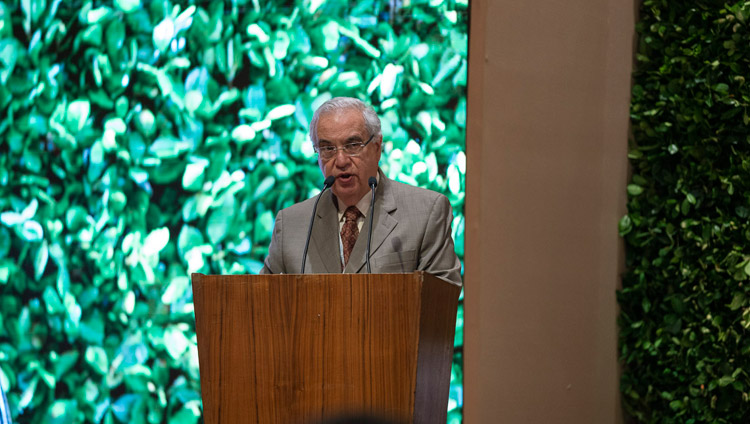
“It is indeed a great honour to have His Holiness here to unveil the curriculum, ”Geshé Lobsang Tenzin Negi agreed, “he has provided us with vision and inspiration. The SEEL program whose launch we are celebrating represents decades of effort on his part to bring about a change in education. To be useful it must be based on a good heart. His Holiness inaugurated the Emory-Tibet partnership in 1998, convinced that people could be taught to develop a warm heart. Since then Emory has also worked to bring modern science to Tibetan monastics.
“In 2015 His Holiness entrusted us with the development of this curriculum. We drew on what he has written in ‘Ethics for the New Millennium’ and ‘Beyond Religion’, as well as Daniel Goleman and Peter Senge’s ‘Triple Focus’. Geshé Thupten Jinpa has also been an inspiration. I would like to thank His Holiness and the Emory President for supporting us and the Deans without whose backing we could not have succeeded. Now, I request His Holiness to unveil the four volumes of the SEE Learning Program.”
Assisted by Manish Sisodia and Kailash Satyarthi, His Holiness unwrapped the package and the three of them held the books up for all to see.
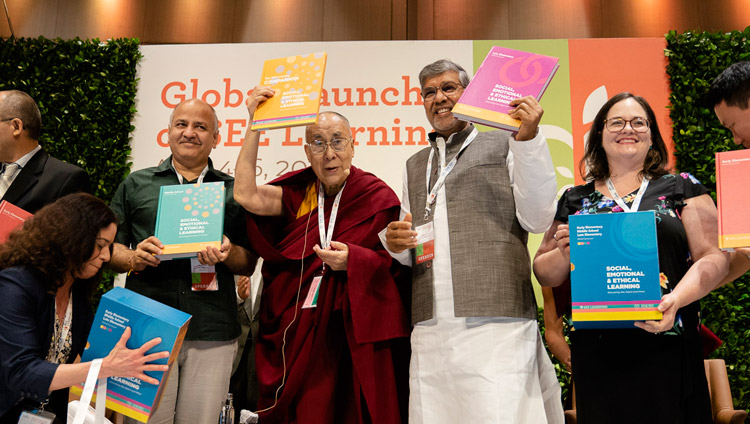
After a brief video about the program, Deputy Chief Minister of Delhi and Minister of Education Manish Sisodia addressed the gathering.
“Good morning. As a human being I can say that this SEEL program is a great gift to humanity. We are trying to solve problems and here is a solution, which is something everyone needs and wants. We try to bring about peace by imposing laws or employing weapons, but the real solution to hatred and violence is to provide training in social emotional and ethical learning. In Delhi, last year, we introduced a similar Happiness curriculum in our schools with many positive results. I congratulate the team who have worked on this and their supporters. It is a practical contribution.”
Kailash Satyarthi, who was awarded the Nobel Peace Prize in 2014 for his struggle against the suppression of children and young people and for the right of all children to education, spoke next. He commended His Holiness as a great teacher, mentor and friend. He attributed the positive qualities of a child to His Holiness, clarifying that he was referring to children’s candour and transparency.
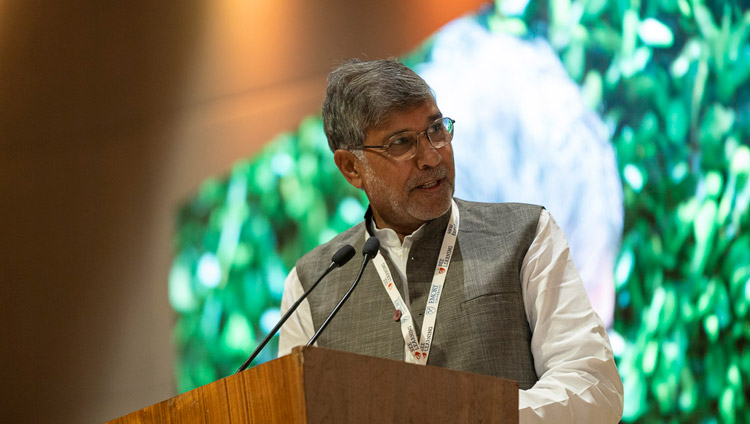
“I hope SEEL will change my view of education. At birth children are clear but through education learn to adopt identities that lead to the division of humanity. Children did not create boundaries and borders. We don’t need to teach children compassion, we need to learn compassion from them. The world is as it is because of a lack of compassion. Dear friends, I hope that through programs such as this compassion will become a way of life. It should be part of us. We need business with compassion, politics with compassion—ask your politicians to be compassionate. Faith leaders too should learn about compassion.”
When it came to His Holiness’s turn, he chose to speak from the podium.
“Respected brothers and sisters, I am one of the 7 billion human beings alive today and this gathering is concerned with the well-being of humanity. Among the different species of mammal, humans are the most mischievous. Other sentient beings may also have anger, attachment and a sense of ‘I’, but the extent of their action is limited. We human beings can be the most destructive. On the other hand, if we use our intelligence constructively, we can also do immense good.
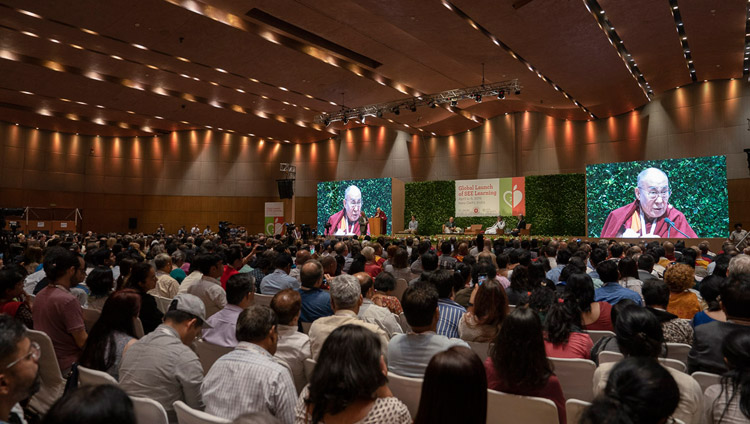
“It is basic human nature to be good and compassionate. Richard Moore here is a living example of this. When he lost his sight, his first thought was not of anger, but regret that he could no longer see his mother’s face. He didn’t store up anger towards the soldier who shot him. Instead they became friends.
“Once children enter into the education system, there’s not much talk about human values. They become oriented towards material goals while their good qualities lie dormant. Education should help us use our intelligence to good effect, which means applying reason. Then we can distinguish what’s in our short and long term interest. Used properly our intelligence can help us be realistic; anger makes us short-sighted.
“Destructive emotions are based on taking appearances as they are, whereas with intelligence we can understand at a deeper level that there is a gap between appearance and reality.
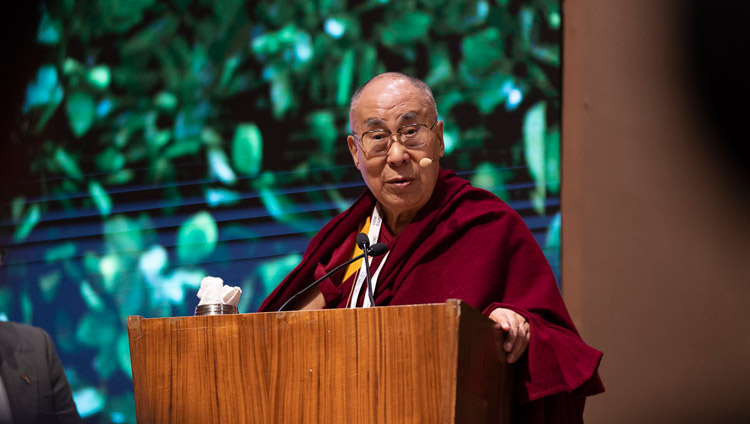
“The results of this program and curriculum will not be seen next week, but in the course of the next generation when we might see more compassionate human beings, happier individuals and families. Because climate change is such a serious threat, we need to have a strong sense of community and a strong sense that in being human we are all the same. Differences between us are secondary. We are all human beings and we all share this one planet that is our only home. Because of that we have to take better care of it. We must cultivate compassion not only for our fellow human beings, but also for the other animals, birds and insects with whom we share the world. That’s all; thank you.”
In the panel discussion that followed, Daniel Goleman explained in a video message how SEL programs had followed his publication of ‘Emotional Intelligence’ and how SEEL is an improvement on them. Kimberly Schonert-Reichl announced that SEL has been taken up in 37 countries. She clarified that what matters is that social and emotional skills can be taught. Previously it was thought that empathy could not be taught or learned, now it’s clear it can. It is now evident too that students who engage in SEL improve their academic achievement by 11%.
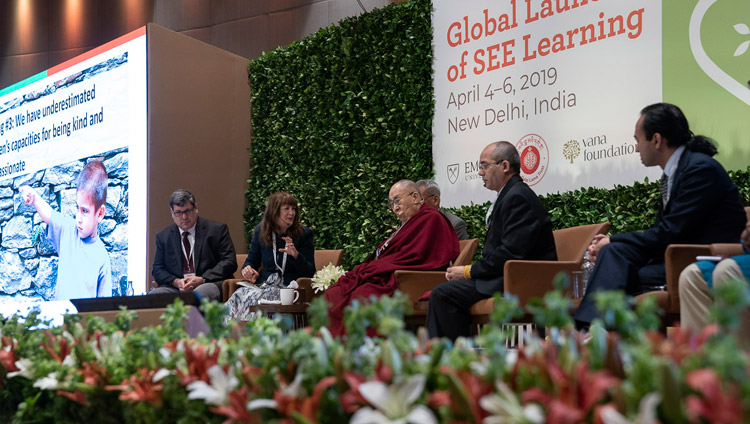
Robert Roeser added that compassion is not only good those who are helped, the helper benefits too. He reported that it is now known that even young children are concerned about others.
His Holiness intervened to point out that there is a natural sense of compassion based on attachment to relatives and friends. It’s limited in scope but can be like a seed that intelligence can develop. Extensive compassion that includes strangers and even enemies can only be developed through training.
Brendan Ozawa-de Silva outlined the framework of SEEL, providing a scientific definition of compassion that involves recognizing suffering, understanding others’ suffering, being motivated to relieve them and knowing what to do. He also showed how SEEL affects personal, social and systems domains while involving different dimensions of awareness, compassion and engagement.
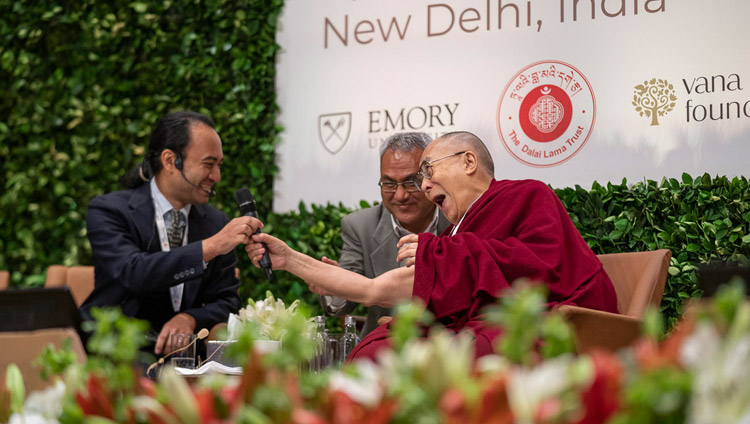
Finally, founder of the Kaivalya Education Foundation, Aditya Natraj reported that he and his colleagues had asked what is worth learning and concluded it was freedom from conditioned thinking. Working with children has taught him that often the problem is not with children but with adults. Consequently there is a recognised need to help teachers and educationists develop compassion. This is approached in the belief that all human beings are good and want to do good, but are stuck in the system they find themselves in.
He talked about a teachers’ union leader who came to him swearing that he could not be changed, who has since become a great advocate of compassion training. Another story that amused the audience was of a woman who wanted to know what he’d done to her husband. Previously, she said, he would come home to talk about politics and demand tea. Since working with Natraj he would come home and first ask after her well-being.
His Holiness remarked,
“In classical Indian tradition, whatever comes about through causes and conditions must be subject to change, therefore naturally human beings too can change. And an obvious change is that when we came here our stomachs were full; now they’re empty.”
He was joined by the panelists and other invited guests for lunch.

